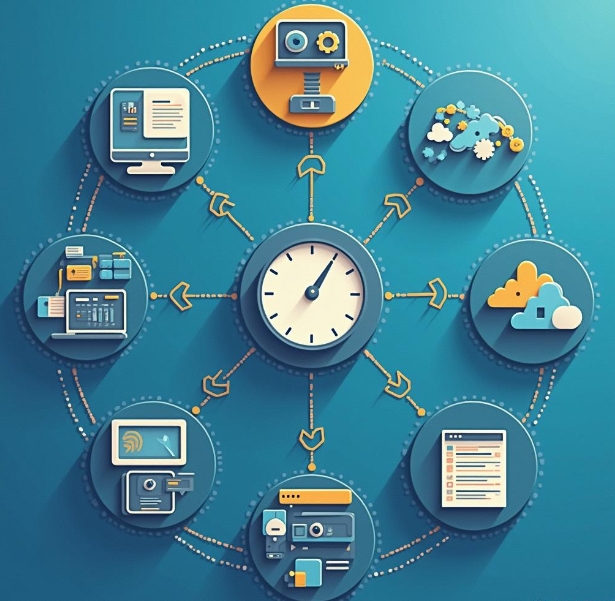Analysis of Machine Learning Development: Technological Innovations Driving the Intelligent Era
- latest articles
- 1.DApp Development & Customization: Merging Diverse Market Needs with User Experience 2.Analysis of the Core Technical System in DApp Project Development 3.How to achieve cross-chain interoperability in Web3 projects? 4.How does the tokenization of points reconstruct the e-commerce ecosystem? 5.How to Set and Track Data Metrics for a Points Mall? 6.What is DApp Development? Core Concepts and Technical Analysis 7.Inventory of commonly used Web3 development tools and usage tips 8.Development of a Distribution System Integrated with Social E-commerce 9.Six Key Steps for Businesses to Build a Points Mall System 10.What is DApp Development? A Comprehensive Guide from Concept to Implementation
- Popular Articles
- 1.Future Trends and Technology Predictions for APP Development in 2025 2.Analysis of the DeFi Ecosystem: How Developers Can Participate in Decentralized Finance Innovation 3.From Zero to One: How PI Mall Revolutionizes the Traditional E-commerce Model 4.DAPP Development | Best Practices for Professional Customization and Rapid Launch 5.Recommended by the Web3 developer community: the most noteworthy forums and resources 6.From Cloud Computing to Computing Power Leasing: Building a Flexible and Scalable Computing Resource Platform 7.Shared Bike System APP: The Convenient Choice in the Era of Smart Travel 8.How to Develop a Successful Douyin Mini Program: Technical Architecture and Best Practices 9.How to Create a Successful Dating App: From Needs Analysis to User Experience Design 10.From Design to Development: The Complete Process of Bringing an APP Idea to Life
Over the past few decades, the rapid development of artificial intelligence (AI) and machine learning (ML) technologies has fundamentally transformed the way we work and live. The advent of the intelligent era relies on the continuous evolution of machine learning, which has brought unprecedented changes to various industries. From finance and healthcare to transportation and retail, the applications of machine learning are ubiquitous, driving improvements in social productivity and creating immense economic value. This article will provide a detailed analysis of machine learning from aspects such as its definition, principles, application scenarios, and development trends, exploring how this technology has become the driving force of the intelligent era.
I. Definition and Development History of Machine Learning
Machine learning is a branch of artificial intelligence that involves using algorithms to enable computer systems to learn from data, identify patterns, and make autonomous decisions or predictions. Within the framework of machine learning, computers no longer rely on traditional programming but instead analyze large volumes of data to automatically discover relationships within the data and use these relationships to solve practical problems.
The origins of machine learning can be traced back to the Turing Test in the 1950s, when scientists began exploring how to make computers simulate human intelligent behavior. With the enhancement of computational power and the explosion of data volume, machine learning technology has developed rapidly in the 21st century. Particularly after the rise of deep learning, the capabilities of machine learning have been unprecedentedly enhanced.
II. Basic Principles of Machine Learning
The core of machine learning lies in its "learning" process. Generally, machine learning algorithms are divided into three main categories: supervised learning, unsupervised learning, and reinforcement learning.
1. Supervised Learning: Supervised learning is the most common approach in machine learning. In supervised learning, algorithms are trained using labeled datasets to learn the relationship between inputs and outputs, ultimately enabling predictions on unknown data. For example, by training with a large dataset of labeled images, a classification model for cats and dogs can be developed, which can then determine whether a new image contains a cat or a dog.
2. Unsupervised Learning: Unlike supervised learning, unsupervised learning does not use labeled data. In this learning approach, algorithms analyze the structure and patterns within the data to discover inherent regularities on their own. For instance, clustering algorithms can group user behavior data into multiple clusters based on similarity without prior knowledge of the data categories.
3. Reinforcement Learning: The fundamental idea of reinforcement learning is to help an agent (such as a robot) find the optimal behavioral strategy in an environment through trial and error and reward mechanisms. This method is similar to how humans continuously optimize their decision-making through experience and feedback. Reinforcement learning is widely applied in areas such as autonomous driving and game AI.
III. Application Scenarios of Machine Learning
The applications of machine learning are almost ubiquitous across various industries, and as the technology matures, the application scenarios continue to expand. Here are some typical applications of machine learning:
1. Financial Industry: In the financial sector, machine learning is widely used in risk assessment, fraud detection, stock prediction, and more. By analyzing large volumes of historical data, banks and financial institutions can build accurate credit scoring models to effectively assess customers' credit risks. Machine learning algorithms can also identify unusual patterns of fraudulent behavior, helping to detect and prevent financial fraud in a timely manner.
2. Healthcare: In the healthcare field, machine learning can assist doctors in disease diagnosis by analyzing medical images, patient records, and other data. For example, deep learning models can help doctors quickly identify tumors or other abnormal lesions by analyzing medical images such as X-rays and CT scans. Additionally, machine learning can predict the occurrence and progression of diseases, aiding in personalized treatment for patients.
3. Smart Manufacturing:In manufacturing, machine learning can help businesses achieve intelligent production, optimize production processes, and improve production efficiency. For example, using real-time data collected by sensors, machine learning can predict equipment failures and perform preventive maintenance before issues occur. Machine learning can also optimize production scheduling, enhance resource utilization, and reduce production costs.
4. Intelligent Transportation: In the field of intelligent transportation, the application of machine learning technology is changing the way we travel. Autonomous driving technology is a typical example, where perception systems collect traffic data, and machine learning algorithms analyze this data to make real-time driving decisions, reducing traffic accidents and improving traffic efficiency. Additionally, machine learning can be used for traffic flow prediction, helping urban traffic management departments optimize traffic signal control and alleviate congestion.
5. Retail and E-commerce: The retail and e-commerce industries use machine learning to provide consumers with personalized recommendations, enhancing the shopping experience. For instance, by analyzing user purchase history, browsing records, and other data, machine learning algorithms can predict consumer needs and recommend relevant products. Machine learning also helps merchants optimize inventory management, forecast sales trends, and avoid overstocking or stockouts.
IV. Development Trends of Machine Learning
With continuous technological advancements, the development trends of machine learning are also evolving. Here are some key directions:
1. Further Development of Deep Learning: As a branch of machine learning, deep learning has achieved significant breakthroughs in fields such as computer vision and natural language processing. In the future, with increased computational power and larger datasets, deep learning will continue to drive advancements in artificial intelligence, particularly in areas like image recognition, speech recognition, and autonomous driving.
2. Growth in Cross-Domain Applications: Machine learning will no longer be confined to specific industries but will achieve cross-domain integration in multiple fields. For example, the combination of healthcare and finance, or smart manufacturing and big data analytics, may bring about entirely new application scenarios and business models. Deep integration across domains will usher in the era of intelligence.
3. Improved Interpretability and Transparency: As machine learning becomes widely applied across various industries, explaining the decision-making processes of machine learning models has become a critical issue. In the future, the interpretability of machine learning will be further enhanced, making algorithmic decision-making processes more transparent. This is essential for increasing trust in algorithms and avoiding potential biases and errors.
4. Integration of Edge Computing and Machine Learning: With the proliferation of IoT devices, an increasing amount of data is being generated and transmitted to the cloud for processing. However, as data volumes surge, effectively handling this data has become a major challenge. Edge computing can move data processing closer to where the data is generated, reducing data transmission delays and improving system responsiveness and efficiency. In edge computing, the application of machine learning algorithms will further optimize device performance and data processing capabilities.

V. Challenges and Future Prospects
Although machine learning has made significant progress in many fields, it still faces several challenges. First, data quality and data privacy remain persistent issues. In many application scenarios, machine learning algorithms rely on large amounts of high-quality data, but the process of acquiring and cleaning this data is often cumbersome and may involve personal privacy protection concerns. Second, the "black box" problem of machine learning algorithms is another issue that urgently needs to be addressed. In many cases, the decision-making processes of machine learning models lack sufficient transparency, which can lead to distrust and concerns about algorithmic bias. Finally, machine learning technology requires substantial computational resources, and reducing its computational costs while improving efficiency is an important research direction.
Despite these challenges, the prospects for machine learning remain very promising. With continuous algorithm optimization, improved hardware performance, and the expansion of application scenarios, machine learning will play an increasingly important role in the future era of intelligence. Whether in driving economic development, enhancing social welfare, or transforming our work and lifestyles, machine learning will be a core force driving technological innovation.
Conclusion
As one of the core technologies of artificial intelligence, machine learning is driving transformations across industries at an unprecedented pace and scale. With continuous technological advancements, machine learning not only solves complex problems in practice but also creates new opportunities, reshaping the way the world operates. In the wave of the intelligent era, machine learning is undoubtedly a vital force leading technological innovation, and every future innovation and breakthrough will be closely linked to it.
-

How does artificial intelligence technology transform the operational models of modern enterprises?
In the wave of the digital era, artificial intelligence (AI) technology has tran···
-

How to Utilize Artificial Intelligence for Precision Medicine and Health Management
With the rapid advancement of technology, artificial intelligence (AI) has demon···
-

Integration and Application of Artificial Intelligence and Robotics
In today's era of rapid technological advancement, the integration of artificial···

 Blockchain
Blockchain











